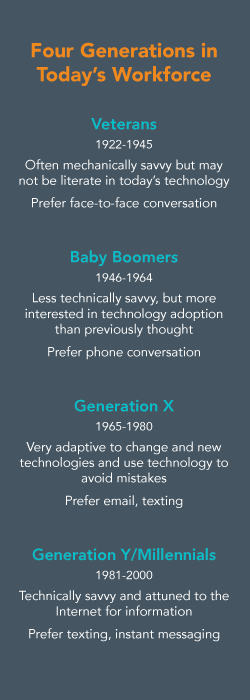Working with multiple generations in any field can be challenging, and human services is no exception. Most challenging can be helping all employees – from directors to caseworkers – utilize technology in human services when workers have very different comfort levels using systems like case management systems, electronic document management software in the office or even tablets in the field.
Right now, four generations of workers comprise the workforce:
- Veterans, sometimes called The Silent Generation
- Baby Boomers
- Generation X
- Millennials, sometimes called Generation Y
Speaking in stereotypes, younger workers (Gen X and Millennials) are technically savvy and rely heavily on technology in their day-to-day life. This transcends to work. Younger workers, who comprise 45% of the workforce, view using mobile devices in meetings to capture notes or quickly access the Internet to find information as an advantage.
On the flip side, older generations (Baby Boomers and Veterans) may find using technology in meetings to be rude or distracting because they prefer less technology-driven interactions through in-person meetings or phone calls. They tend to be less literate in technology than their younger counterparts, but have an interest in learning more.
What does this means for social services agencies?
Agencies need to keep the generational differences in learning and communication in mind when implementing new technology. Here are key strategies to help make the transition smooth.
Build on the skills of each generation to benefit the whole team
Here’s an example. A social services agency is establishing a new electronic document management system. Workers from older generations can excel on the mechanics of a new project. Veterans can provide expertise of business processes and metrics from years of experience. Baby Boomers are well positioned to serve as the project manager or coordinator because of a strong network of contacts and good face-to-face communication skills.
In dealing with younger workers, Gen Xers and Millennials make good pilot teams to try new technologies because they are tech savvy and eager to learn. They can then serve as coaches and mentors for the older generations, who are often afraid they will break technology or use it incorrectly.
By leveraging the skill set of each generation, everyone has a distinct role and feels like they are part of the team, which greatly improves the likelihood a technology project will succeed.
Train employees on new technology based on each generation’s learning style
The younger generations tend to have shorter attention spans and often prefer verbal and hands-on training to reading documents, whereas older generations prefer to read documentation and take time to internalize new processes.
The key here is to remember no one-size training will ever fit all. Technology training needs to accommodate a variety of different learning styles.
For Millennials and Gen Xers, consider short video tutorials; specific, bulleted how-to documents; and interactive, technology-based training to allow workers to jump right in.
Veterans and Baby Boomers may benefit from longer, written explanations of the new system before formal training. They may favor more traditional training methods, such as PowerPoint presentations, than their younger counterparts. These generations may also benefit from post-training tutorials to review new skills since they may not pick up on technology quite as quickly.
Keep in mind that these strategies are based on generalizations about millions of people who happened to be born during the same timeframe. Some Millennials may be petrified of trying something new like taking a tablet on a home visit, while a Baby Boomer might think writing case notes in a yellow legal pad is as outdated as a Sock Hop.
Regardless of their generation, workers who receive information, training, and support from human services agencies through a variety of communication methods will excel when using new technology.
Working with multiple generations in any field can be challenging, and human services is no exception. Most challenging can be helping all employees – from directors to caseworkers – utilize technology in human services when workers have very different comfort levels using systems like case management systems, electronic document management software in the office or even tablets in the field.
